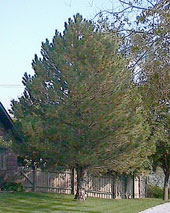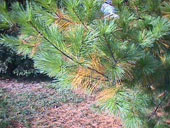Blog
Fall Needle Shed
Causes of Needle Browning & Needle Shed
 Yellowing and browning of needles in the fall is a normal occurrence on pine, spruce, cedar and juniper. The discolouration, which affects the older needles closer to the trunk, can begin in early August and continue until freeze up. Needle drop can occur in the fall or over the winter months. In the spring, a large amount of needles may be noticed on the ground underneath the plants.
Yellowing and browning of needles in the fall is a normal occurrence on pine, spruce, cedar and juniper. The discolouration, which affects the older needles closer to the trunk, can begin in early August and continue until freeze up. Needle drop can occur in the fall or over the winter months. In the spring, a large amount of needles may be noticed on the ground underneath the plants.
Conifers do not keep their growth of needles on their branches while spruce keep up to seven years growth. Occasionally, plants will retain their needles for several years before dropping them. The amount of natural shedding can Fall Needle Drop on Eastern White Pine Photo from University of Nebraska-Lincoln Extension be greater if the trees or shrubs are placed under any stress such as drought, flooding, insect or mite attack. Needles that are dropped are not replaced; this is why evergreens are bare of needles in the centre of the plant near the trunk.
Other Causes of Browning
 There are other reasons for discoloured needles to occur on trees and shrubs. Some of the more common causes are:
There are other reasons for discoloured needles to occur on trees and shrubs. Some of the more common causes are:
- Needle cast fungi – causes needle drop in pines and spruce in the spring or early summer. Needle browning appears on the newest growth and moves inwards on the branch. A large number of lost needles gives the plant a sparse and straggly appearance. If the disease is severe, all that may remain are tufts of needles at the ends of the branches. When the disease progresses to this point, the plant cannot produce enough food and it slowly dies.
- Small, black, oval fruiting bodies – may be seen in the straw-coloured areas on the infected needles. These fruiting bodies produce spores which will spread the infection. If chemical control is to be used, it must be applied just before the spores are released. Therefore, proper identification of the fungus is necessary. Non-chemical control involves raking up and destroying all fallen needles.
- Dog urine – damage is most frequently seen on the lower one metre of cedars, although junipers and other small ornamental trees and shrubs may be affected. With cedars, the branches of needles turn black and die. Injured branches can be pruned off.
- Winter injury – causes browning or reddening of needles and is most noticeable in the spring. Do not apply excessive amounts of nitrogen fertilizer in late summer and fall. This will promote succulent growth that may not mature before winter.
- Insect pests and mites – can also cause yellowing and browning of needles throughout the growing season. For more information on these pests and their control, see the Alberta Agriculture and Rural Development website
Contact us today to learn more.
 1-877-444-8733
1-877-444-8733